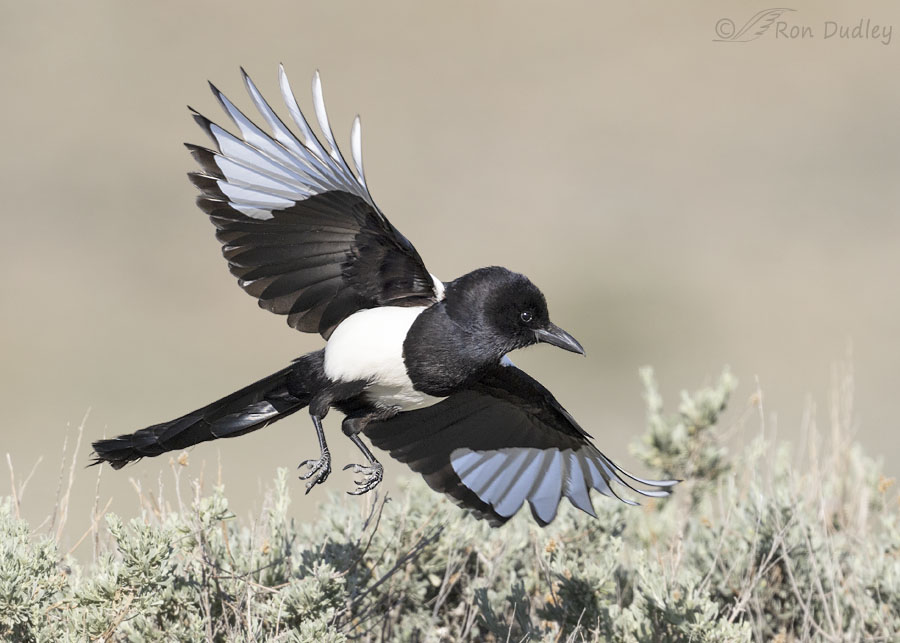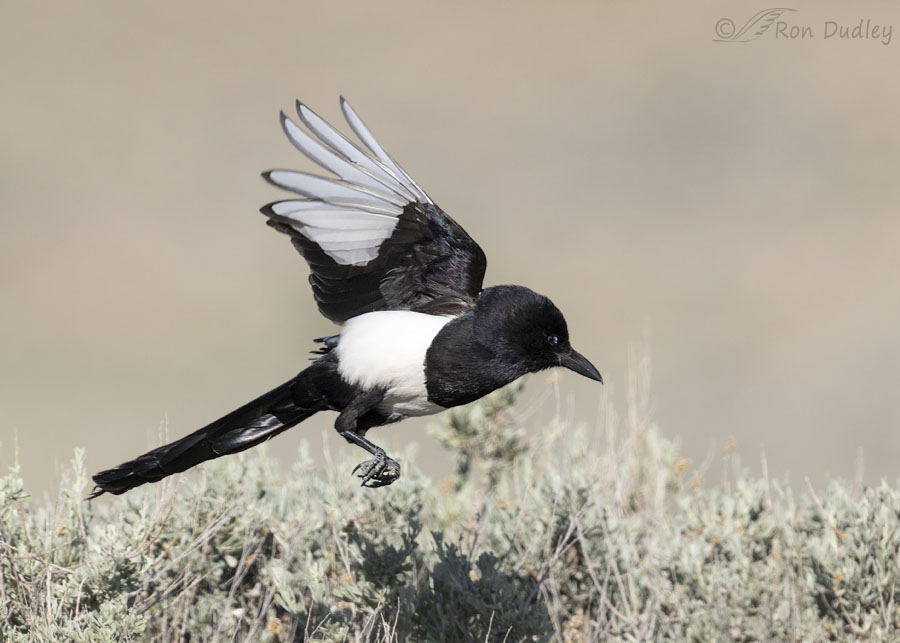And what about the head size and shape of this magpie – is it a little different?
Three days ago I mentioned that on my last visit to Antelope Island I didn’t see a single Black-billed Magpie, which was highly unusual and at least a little alarming. Readers know that I’m very fond of magpies so yesterday, in a fit of nostalgia, I reviewed the most recent magpie photos I’ve taken on the island and came across this one that I’m surprised I haven’t posted before.
This bird is actually the last magpie I photographed this season, nearly two months ago on May 18th.

1/3200, f/6.3, ISO 500, Canon R5, Canon EF500mm f/4L IS II USM + 1.4 tc, not baited, set up or called in
I like the photo and find it interesting for a lot of reasons but two of them stand out.
Almost without exception in photos like this I can tell if the bird is about to land or has just taken off by looking at its flight posture, leg and tail position and the direction it’s looking. But in this photo I can’t, at least not for sure. And even though I saved the next photo in the burst (which I haven’t included here), I can’t tell for sure in that second photo either. If I had to guess I’d say this bird is landing but, as I’ve said before, landing shots are much more difficult to get, which makes me a little skeptical about my guess.
Over the years I’ve seen a lot of magpies up close but this one looks a little different to me and I find that difference appealing. It’s all about the apparent size and shape of the head of this bird, which seems larger and rounder than usual for the species, at least to me. I think it’s an attractive look. And that head shape isn’t only apparent in this photo, I also see it in the next photo in the burst.
OK, I’ve rambled on long enough. I just hope I see magpies on my next visit to the island.
Ron
PS – While I was reviewing this post just prior to publication I realized that I mentioned “the next photo in the burst” twice without including it and I thought that might be a little aggravating to my readers. So here it is, quickly processed and for what it’s worth.

1/3200, f/6.3, ISO 500, Canon R5, Canon EF500mm f/4L IS II USM + 1.4 tc, not baited, set up or called in


I’m so far behind…
Anyway, i’m comparing this photo with your photo from the April 14, 2015 entry and even the bill looks different. Huh, is it a youngster?
Hope you’re continuing to recover and enjoy life.
Oh, do NOT aggravate your readers, you know we can be an insufferable bunch when aggravated! 😂
I guess I haven’t spent enough time looking at magpies (which I do see occasionally) to have an opinion on this bird’s head size/shape, but I’m in the “wheels up” club on the other question!
And I watched a Mourning Dove “snorkle” drink in the fountain yesterday, then a crow came in and saw him demonstrate Lyle’s “gargle” action. So interesting!
Chris, it’s interesting to compare their different techniques isn’t it.
That IS a very round head. Which immediately made me think of English history, despite there being no Cavaliers in sight.
I would opt (from my usual state of ignorance) for a take off shot because in the second photograph is landing gear is more retracted.
Roundheads vs Cavaliers – with my English ancestry I remember reading stuff about that. I guess that’s also where the ‘Cavalier’ in Cavalier King Charles Spaniel came from.
My thought is that the head looking big and the body shortened is due to the same effect you get when you take a photo of someone laying down with the camera placed at their feet. Either that or it’s a genetically altered Magpie Mutant.
I like Granny Pat’s wheels up theory.
We had Mourning Doves in the yard yesterday. Sure enough, drinking without the “gargle” action.
Lyle, yesterday I watched both Mourning and Eurasian Collared Doves doing the same thing.
Love that first photo. Very sharp throughout the body, face, wings, feet, beak, etc. Interesting that both Judy and Michael who have seen more Magpies than I have don’t 100% see Magpie. Very clearly says Magpie to me. Strongly see this as a take off with those feet retracting in the second photo.
Are these pre R5 photos?
Thank you, Everett. Yes, R5 photos. I named the camera in my image techs below the photos.
Other than it’s coloring it’s body/head really doesn’t say “Magpie” to me… Interesting! Always a twist on things to keep us guessing…. 😉 No insight on to take off or land tho the feet don’t appear to be ready to grasp anything.
Judy, I’m glad to know that I’m not the only one who thinks its proportions look a little ‘off’.
The shots, as usual are great, sharp and clear but like thousands of other such shots on the ‘net would be soon forgotten. What makes them stand out and be memorable for a long time are your speculations and the questions you ask. My best guess is that its a takeoff shot because the feet in the second shot are pulled up closer to the body and are more tightly together. I have nothing to go on except thoughts of aircraft pulling up their wheels. Right or wrong it will have me paying a lot more attention to details like that in the future and that is an ongoing gift.
“it will have me paying a lot more attention to details like that in the future”
Good! Paying attention to detail is important in bird photography. Thank you, Granny Pat.
When I first looked at the photo (before reading the text) I remarked to myself that the scale of the whole bid looked differently than other magpie photos I have seen or even memories of magpies I’ve seen in the field (we have them in central California). Don’t know if it’s just an illusion caused by the angle of the camera or the ruffling of head feathers, but there is something different. Photos, like the human eye, can sometimes result in an atypical image. Whatever the case, I’m with you on this one.
I agree, Michael. And since the bird has the same look in both photos I don’t think it’s an illusion.